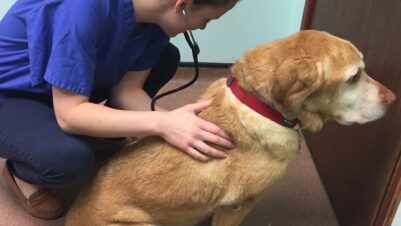The dog is a social species that has a fundamental drive for social contact (McCrave, 1991). When separated from the dam or litter, puppies engage in a variety of unconditioned behaviours that function to regain social contact (Borchelt and Voith, 1982), including whining, crying and attempting to follow the maternal figure. In the natural environment, these behaviours result in reuniting the young and parent and the distress response ceases (McCrave, 1991; Taylor and Mills, 2007). Dependence on the dam, littermates and nest site develops as a result of the puppies learning to respond to cues in the environment (Appleby and Pluijmakers, 2003). Over time, the stability this provides enables the puppy to explore and interact with their environment, resulting in greater independence. The natural weaning process then further reduces dependence on the dam as she becomes less salient, less responsive and less tolerant.
The term “separation-related behaviour” is used to describe any behaviour that only occurs when a dog is left alone (or when predicting a separation may be imminent) or in the absence of an attachment figure (this may be a human or animal). The behaviour may happen every time they are alone or the attachment figure has departed or may only happen in particular contexts (eg when left during evenings or out of routine). Symptoms typically include vocalising, destruction, toileting (either as an involuntary physiological effect of extreme distress or territorial marking to release anxiety), attempts to prevent a person from leaving, panting, excessive salivation, vomiting, self-mutilation, repetitive behaviours, inappetence and complete withdrawal (McCrave, 1991; Blackwell, 2008).
Research has shown that in the UK, between 13 and 29 percent of dogs exhibit signs of separation-related behaviour (Casey, 2013; Ballentyne, 2018), but these figures only include owners who recognise symptoms. There are many owners who perceive their dogs to be relaxed when left alone, yet one study found that 80 percent of dogs who showed no active signs of separation-related behaviour did show signs of anxiety and stress when assessed by means of video footage and salivary cortisol samples (Blackwell and Casey, 2014).
Developmental window of opportunity
Dogs have a primary socialisation period between approximately 3 and 16 weeks of age (Freedman et al., 1961; Scott and Fuller, 1965; Fox, 1978) when they are particularly sensitive to learning about social environments and situations which are likely to recur (Bradshaw et al., 2002). This sensitive period becomes less plastic around 18 weeks of age when dogs enter a more independent and fearful stage. Puppies that do not have the opportunity to encounter particular experiences during this period are more likely to develop a fear response to those situations when they are older (Appleby et al., 2002). Habituation can be defined as the process whereby an animal becomes accustomed to environmental stimuli (Bowen and Heath, 2005). It involves exposure to mildly arousing stimuli or environments to allow acceptance of the situation (Mills, 2005).
Puppies need to start learning that being separated is not frightening from around three weeks of age, so it is the breeder’s responsibility to start this process. The time that each puppy is kept away from its littermates should be increased gradually, starting with momentary removal with immediate replacement in the litter. By building up this process whilst ensuring that the puppy does not show signs of distress, puppies should be in a much better position to continue learning about isolation once in their new homes (Casey, 2016).
Prevention is better than cure
After rehoming, overdependence may be unintentionally reinforced if puppies are not given the opportunity to learn to cope with time away from their new owners (McCrave, 1991). The important principle is for new owners to gradually build up the period that the puppy is left alone, including at night time (Casey, 2016).
A safe area where the puppy will be left alone should include a comfortable bed as well as space for the puppy to rest elsewhere (if they get too hot or want to stretch out, for example). Enrichment in the form of novel items to explore and self-reinforcing activity feeders such as Kongs and LickiMats can be used to create positive associations with this area. Teaching the puppy to settle in their safe space and then gradually building up distance away from them whilst remaining in the home is a sensible starting point. Once the puppy can remain relaxed with the owner moving around the home and out of sight, absences out of the house can be trialled. At night time, owners can start with providing human company and then over the proceeding days/weeks segregation can be implemented. Diffusers exist which reduce signs of stress in puppies left alone (Taylor and Mills, 2007; Gaultier et al., 2008).
It’s important to remember that puppies have spent all their lives with their mum and/or littermates and in the only environment they have ever known. Leaving a puppy to cry-it-out can be a precursor for separation-related behaviours, so setting them up for success in the first place so they show minimum distress at night is preferable.






